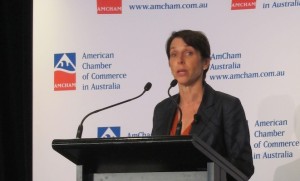Jetstar group chief executive Jayne Hrdlicka says a key lesson so far from the long and somewhat tortured process to get the low-cost carrier’s proposed Hong Kong franchise off the ground has been the need for patience.
The wait for regulatory approval to start flying has stretched well into a fourth year since Qantas chief executive Alan Joyce and China Eastern chairman Liu Shaoyong unveiled plans to set up a Jetstar franchise on the doorstep of China in March 2012.
To highlight how they perhaps misjudged what it would take for Jetstar Hong Kong to fly, the joint-venture partners said in 2012 the airline was expected to be up and running in a year and have a fleet of 18 Airbus A320s by 2015. Today, Jetstar Hong Kong is down to one aircraft – to be used for route proving and staff training – having sold a series of A320s while it continued to wait for an air operator’s certificate (AOC).
Hrdlicka, Jetstar group chief executive since July 2012, says she is still “very confident” about Jetstar Hong Kong’s prospects.
“We’ve learned the importance of patience in Hong Kong and not underestimating the importance of carefully and thoughtfully working through the process with the government,” Hrdlicka told reporters on the sidelines of the International Air Transport Association annual general meeting in Miami on June 7.
“Our expectations were not lined up with the reality of the way this government’s making decisions in Hong Kong and we are perfectly comfortable with that.
“We’ve got two shareholders who have more experience being patient and long-minded than we do and we are learning through that process.”
The proposed Jetstar Hong Kong airline, which would be the fourth Jetstar franchise in the fast-growing Asian region behind Singapore’s Jetstar Asia, Vietnam’s Jetstar Pacific and Jetstar Japan, is awaiting regulatory approval to start flying.

The Hong Kong Air Transport Licensing Authority was currently considering the airline’s application for an operating licence and held an inquiry to consider the matter in January.
The authority will determine if Jetstar Hong Kong satisfies the nation’s principal place of business laws and therefore is able to access international traffic rights as a Hong Kong-designated carrier.
Jetstar Hong Kong has now sold eight of its nine A320s as it waits for approval to fly. The most recent sale took place in March, when two Airbus narrowbodies were sold to a Chinese company, CMB Financial Leasing Co, for US$83 million.
The proposed low-cost carrier has met fierce opposition from Hong Kong Airlines and Cathay Pacific, who both have argued Jetstar Hong Kong did not meet the principal place of business requirements contained in Hong Kong’s Basic Law, arguing all major decisions will be made by Jetstar’s Melbourne head office.
In response, Jetstar Hong Kong has said it had local management, a Hong Kong chief executive and was run and managed by a separate board. Following a change to the shareholder voting structure in 2014, Hong Kong conglomerate Shun Tak Holdings holds a majority 51 per cent of voting rights, with Qantas and China Eastern each having 24.5 per cent voting rights. Ownership levels were unchanged at 33.3 per cent each.

As the process dragged on, there were some concerns raised among aviation analysts the delays would mean that whenever, or if, Jetstar Hong Kong launched it would face a shortage of available slots to expand at Chek Lap Kok International Airport.
As a September 2013 report from CAPA – Centre for Aviation noted: “Any stalling of its application further reduces slot opportunities, and already preliminary slot allocation options are available at commercially weak hours.”
And more recently, Cathay Pacific told the financial community there might be no new slots available within the next two years.
However, the Hong Kong government in March 2015 approved the construction of a third runway, with the HK$150 billion (A$25 billion) project due to be completed by 2023.
Hrdlicka said the commitment to a new runway meant the opportunity in Hong Kong for Jetstar is just as significant now as when the airline was launched in 2012.
“That decision was a big marker in our shareholders’ eyes for the future,” Hrdlicka said.
“The Hong Kong economy needs the tourism flows into Hong Kong.
“For some retail sectors in Hong Kong they are off by 30 per cent so that flow of customers who need low fares to make Hong Kong affordable – to have the Hong Kong experience – is really important to the Hong Kong economy, it is important to the Hong Kong people.”
Hrdlicka said Jetstar’s other Asian franchises were doing well, with the most recent financial results from Singapore’s Jetstar Asia and Vietnam’s Jetstar Pacific showing both airlines were profitable.
And Jetstar Asia was receiving good feeder traffic from the 20-odd airlines it had interline agreements with, especially Emirates, given it was the only real alternative to Singapore Airlines and Silkair at Changi Airport for connections to smaller destinations in the region.
Meanwhile, Jetstar Japan remained in the red as it continued its expansion phase, having launched its first international route – Osaka Kansai-Hong Kong – in February 2015.
















